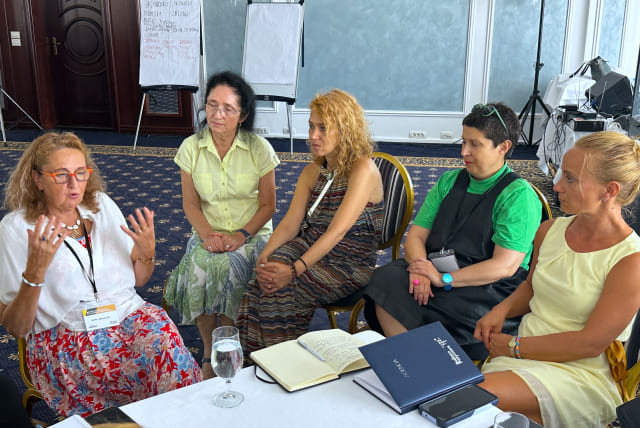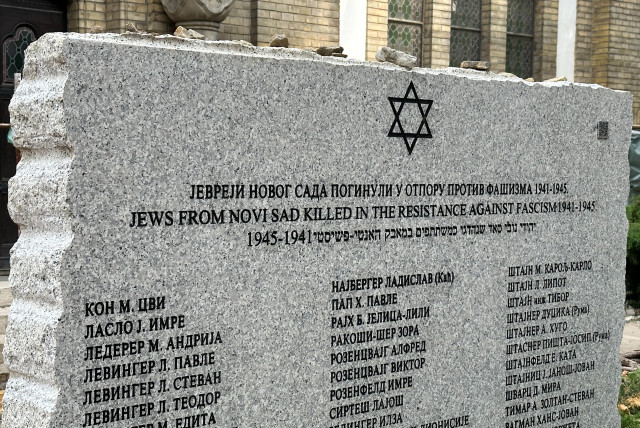As nationalism rises in Serbia, a Holocaust education seminar for teachers gets more popular

In recent years, local fascist and neo-Nazi groups in Serbia have become emboldened under President Aleksandar Vučić.
On a recent morning in the Serbian town of Šabac, 69-year-old Borka Marinković sat around a table with half a dozen schoolteachers, none of them Jewish, and opened up about her complicated life as the daughter of Holocaust survivors.
Marinković’s mother was interned at a concentration camp on the Croatian island of Rab, but in 1943, partisans rescued her, and she joined the resistance effort as a cryptographer. She then met Marinković’s father, a Yugoslavian partisan.
Three years later, after the war ended, they married and began a family, but they rarely spoke of the horrors they had endured. Only at the age of 15 did Marinković, née Salcberger — whose first name means “fighter” — even learn she was a Jew.
“In 1983, I married a Serb and gladly took his family name. Somehow it helped me assimilate into the new society,” said Marinković. “But the ethnic wars of the 1990s gave me flashbacks of the Holocaust, and at some point in my life I felt ashamed that I had kept my Jewish identity secret.”
Marinković, who told her story calmly but brought her entire audience to tears, eventually wrote a book about the tortured experiences of second-generation Holocaust survivors like herself.
“This is my first time speaking with teachers,” Marinković told the Jewish Telegraphic Agency through a translator after her story, which was followed by a breakaway session in which educators discussed how to use the narrative in a classroom setting. “I get emotional when I talk about my parents, but I think this message is very important for future generations.”
Marinković and two other second-generation survivors were participating in a seminar with 30 Serbian teachers at the Hotel Sloboda in Šabac (pronounced SHA-betz), a town on the banks of the Sava River whose small Jewish community was decimated during the war. The hotel is only two city blocks from a branch of the national bank where in August 1941 the Nazis hanged 10 prominent Šabac Jews from electricity poles.
The event was arranged by The Olga Lengyel Institute for Holocaust Studies and Human Rights (TOLI) — a New York-based nonprofit that provides Holocaust education programs to teachers in the United States and Europe — in conjunction with local partner Terraforming, a Serbian civil society organization that teaches about the Holocaust and fights antisemitism and xenophobia.
Svetlana Maksimovic, 43, an English teacher at the seminar from the southern Serbian town of Prokulje, said “Serbs aren’t familiar with the Holocaust.”
“Even well-educated Serbs don’t know much about it,” said Maksimovic, a Serbian Orthodox woman who visited Israel last summer. “I think it’s a really big step for Serbia’s educational system that this topic is now being taught in schools.”
Oana Bajka, the associate director of TOLI International Programs, said the Aug. 21-24 event marked the 54th such seminar for TOLI and the third of its type in Serbia; the previous two, in 2021 and 2022, took place in Novi Sad, about an hour’s bus ride north of Šabac. TOLI now operates in 11 countries throughout Europe: Bulgaria, Croatia, Greece, Italy, Lithuania, Poland, Portugal, Romania, Serbia, Spain and Ukraine.
“In every country, the teachers gain an understanding about the responsibilities of their governments during the Holocaust,” said Bajka, who joined TOLI in 2019 and works from an office in Timasoara, Romania. “That’s one of our big challenges, because often governments have difficulty acknowledging their collaboration with Nazi Germany.”
Frequently, said Bajka, people tend to identify with their nation’s good deeds while overlooking the crimes. For example, she said, “in Bulgaria they talk a lot about saving Bulgarian Jews, and not so much Bulgaria’s role in deporting the Jews from Thrace and Macedonia.”
Under President Aleksandar Vučić, Serbia — like Poland, Hungary and most recently Slovakia — has veered politically to the far right in recent years. Local fascist and neo-Nazi groups are motivated by traditional antisemitism and anti-immigrant sentiment. Anger over the 2008 declaration of independence by predominantly Albanian-speaking Kosovo — which most Serbs consider an integral part of their country — has also fueled the rise of intense nationalism in this country of 7.1 million, which includes about 3,000 Jews.
Antisemitism and Holocaust discourse are issues elsewhere in the Balkans and in parts of Eastern Europe, too. Last year, Romania’s nationalist AUR party issued a statement calling Holocaust education — which had just been mandated in Romanian high schools — a “minor topic.” His comments were condemned by David Saranga, Israel’s then-ambassador to Romania. But on Aug. 28, Saranga’s successor, Reuven Azar, met with AUR’s president, George Simion, after the latter agreed that Romania is indeed responsible for the killing of Jews on territory it held during World War II.
Šabac resident Natalija Perišić decided to take action on the subject after reading the book “Sophie’s Choice.” Author William Styron based Sophie on Hungarian Holocaust survivor Olga Lengyel, whose 1946 book, “Five Chimneys: A Woman Survivor’s True Story of Auschwitz,” was one of the first published accounts about the Nazi genocide.
Perišić says the murder of six million Jews has particular relevance in Serbia, which helped perpetrate the July 1995 massacre of some 8,000 Bosniak Muslim men and boys in the town of Srebrenica during the 1992-95 Bosnian War. In 2013, then-Serbian President Tomislav Nikolić apologized for the “crime” of Srebrenica but refused to call it a genocide.
“We think of ourselves as a nation of people against fascism, and we like to think of Serbian bravery,” said Perišić. “But I do not see that we’ve drawn any lessons from the 1990s.”
Belgrade educator Alexander Todosijevic, president of the Serbia History Teachers’ Association, said that this program was especially timely, given the pressure teachers now face about how they present history.
“It’s very important for Serbian teachers to know about the Holocaust and to be motivated to teach it,” he said, adding that the seminar, which provided pedagogical approaches, has become popular in Serbia. More than 150 teachers applied to take part this year alone.
TOLI also takes its seminar participants to sites “connected to Jewish heritage and local history,” Bajka said. On the program this year was a scholarly presentation about the ill-fated Kladovo transport — a secret effort to help 1,051 Jewish refugees escape Nazi-occupied Europe via the Danube River and Black Sea to then-Palestine. The effort ended in failure when their chartered ship got stranded in Šabac, and the Nazis killed nearly everyone aboard or in the Sajmište concentration camp near Belgrade.
Teachers visited the burned-out remains of a mill that had temporarily housed about 500 refugees from the Kladovo transport, as well as a small synagogue where the Jews of Šabac used to pray.
Katarzyna Suszkiewicz, who heads the education department at Krakow’s Galicia Jewish Museum in Poland, said these teachers are “on the front lines.”
“They have direct contact with youth, and we must support them,” she said. “Local leaders or NGOs don’t have that kind of contact. And if teachers are incompetent or don’t know much, they’ll never risk interacting with students on such a difficult subject.”
Suzkiewicz, 38, isn’t Jewish, but she can relate to the Holocaust because her grandmother was a forced laborer in Germany. In Poland, where 90% of the country’s 3 million Jews were murdered in Nazi death camps, “historical facts put us in a spotlight, and this is something we will never escape,” she said.
“You cannot separate Jewish stories from Polish stories. At some point, I felt robbed because I wasn’t taught much about Jews at school, and so I wasn’t properly prepared for my visit to Auschwitz,” she said. “For many, the Holocaust is very distant. But atrocities are not that far away, and when the war in Ukraine broke out, they realized that Auschwitz can happen again.”
TOLI’s local partner in Serbia, Terraforming, was founded in 2008 by Miško Stanišić. A non-Jew born and raised in Sarajevo, Stanišić fled in 1992 during intense fighting between ethnic Serbs and Bosnians, taking refuge in the Netherlands and later Sweden. He now lives in Novi Sad, Serbia’s second-largest city that was home to a once-sizable Jewish community.
“I believe that the majority population should be in charge of protecting the minority, and giving voice to those who are weak,” he said.
Terraforming has also produced a series of educational graphic novels about the Holocaust based on biographies, said Stanišić.
“They’re not just stories, but combined teaching materials that include primary sources, maps and historical photos. It’s all digital,” he said. “We’re targeting youth from 10 years old up to young adults. There are obviously not enough visual resources to tell these stories.”
Nor are there many eyewitnesses to the Holocaust left in Serbia. In fact, said Stanišić, “just a handful, maybe 10 survivors all in their late 90s. That is why we invite the second generation.”
Maksimovic, the English teacher from Prokulje, became fascinated with the Holocaust after reading “The Letters of Hilda Dajč.” The graphic novel by Aleksandr Zograf is based on the recollections of a Jewish architecture student who volunteered to work as a nurse at the Nazi-run Staro Sajmište concentration camp and was later gassed there — along with 6,000 other women, children and elderly men — in the spring of 1942.
“Her letters really moved me. I compare her to Anne Frank,” Maksimovic said. “We’ve also had wars here and we know what genocide means. It’s very important to introduce this topic from an early age, so that it never happens again. And there’s a way to teach this to children, without the horror, in a way they’ll understand.”
Jerusalem Post Store
`; document.getElementById("linkPremium").innerHTML = cont; var divWithLink = document.getElementById("premium-link"); if (divWithLink !== null && divWithLink !== 'undefined') { divWithLink.style.border = "solid 1px #cb0f3e"; divWithLink.style.textAlign = "center"; divWithLink.style.marginBottom = "15px"; divWithLink.style.marginTop = "15px"; divWithLink.style.width = "100%"; divWithLink.style.backgroundColor = "#122952"; divWithLink.style.color = "#ffffff"; divWithLink.style.lineHeight = "1.5"; } } (function (v, i) { });

